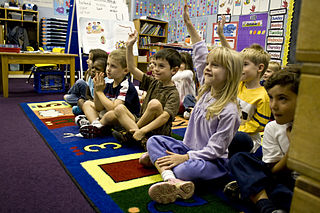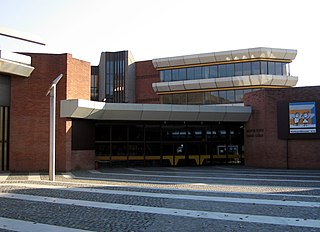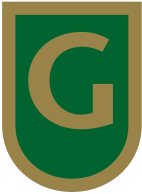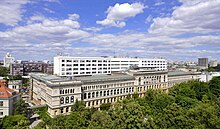
Gymnasium is a term in various European languages for a secondary school that prepares students for higher education at a university. It is comparable to the US English term preparatory high school. Before the 20th century, the gymnasium system was a widespread feature of educational systems throughout many European countries.

Kindergarten is a preschool educational approach based on playing, singing, practical activities such as drawing, and social interaction as part of the transition from home to school. Such institutions were originally made in the late 18th century in Germany, Bavaria and Alsace to serve children whose parents both worked outside home. The term was coined by German pedagogue Friedrich Fröbel, whose approach globally influenced early-years education. Today, the term is used in many countries to describe a variety of educational institutions and learning spaces for children ranging from 2 to 6 years of age, based on a variety of teaching methods.
Abitur, often shortened colloquially to Abi, is a qualification granted at the end of secondary education in Germany. It is conferred on students who pass their final exams at the end of ISCED 3, usually after twelve or thirteen years of schooling. In German, the term Abitur has roots in the archaic word Abiturium, which in turn was derived from the Latin abiturus.

Education in Germany is primarily the responsibility of individual German states, with the federal government playing a minor role. Optional Kindergarden education is provided for all children between one and six years old, after which school attendance is compulsory. Overall, Germany is one of the best performing OECD countries in reading literacy, mathematics and sciences with the average student scoring 515 in the PISA Assessment Test, well above the OECD average of 497 points. Germany has a less competitive system, leading to low rates of bullying and students having a weak fear of failure but a high level of self-confidence and general happiness compared to other OECD countries like South Korea. Additionally, Germany has one of the largest percentage of top performers in reading among socio-economically advantaged students, ranking 3rd out of 76 OECD countries. This leads to Germany having one of the highest-educated labour forces among OECD countries. The Human Rights Measurement Initiative finds that Germany is achieving 75.4% of what should be possible for the right to education, at their level of income.

The education system in Switzerland is very diverse, because the constitution of Switzerland delegates the authority for the school system mainly to the cantons. The Swiss constitution sets the foundations, namely that primary school is obligatory for every child and is free in state schools and that the confederation can run or support universities.

The educational system in Hungary is predominantly public, run by the Ministry of Human Resources. Preschool kindergarten education is compulsory and provided for all children between three and six years old, after which school attendance is also compulsory until age of sixteen. Primary education usually lasts for eight years. Secondary education includes three traditional types of schools focused on different academic levels: the Gymnasium enrols the most gifted children and prepares students for university studies; the secondary vocational schools for intermediate students lasts four years and the technical school prepares pupils for vocational education and the world of work. The system is partly flexible and bridges exist, graduates from a vocational school can achieve a two years program to have access to vocational higher education for instance. The Trends in International Mathematics and Science Study (TIMSS) rated 13–14-year-old pupils in Hungary among the best in the world for maths and science.

A Hauptschule is a secondary school in Germany, starting after four years of elementary schooling (Grundschule), which offers Lower Secondary Education according to the International Standard Classification of Education. Any student who attends a German elementary school can go to a Hauptschule or Gesamtschule, while students who want to attend a Realschule or Gymnasium need to have good marks in order to do so. The students spend five to six years at the Hauptschule, from 5th to 9th grade. They finish around age 15 to 17.

Realschule is a type of secondary school in Germany, Switzerland and Liechtenstein. It has also existed in Croatia, the Austrian Empire, the German Empire, Denmark and Norway (realskole), Sweden (realskola), Finland (reaalikoulu), Hungary (reáliskola), Latvia (reālskola), Slovenia (realka), Serbia (реалка), and the Russian Empire.

→
Educational stages are subdivisions of formal learning, typically covering early childhood education, primary education, secondary education and tertiary education. The United Nations Educational, Scientific and Cultural Organization (UNESCO) recognizes nine levels of education in its International Standard Classification of Education (ISCED) system. UNESCO's International Bureau of Education maintains a database of country-specific education systems and their stages.

The German Swiss International School is an international school in Hong Kong established in 1969 by German and Swiss families looking for a bilingual German-English education in an international setting. Beginning with 73 students in its inaugural year, GSIS now has approximately 1,250 students from over 30 countries.
Education in Croatia is a right defended by Article 66 of the Constitution which states that everyone is entitled to free compulsory education under equal conditions and in accordance with their aptitudes. Education is mandatory for children aged 6 to 14.
Education in Hamburg covers the whole spectrum from kindergarten, primary education, secondary education, and higher education in Hamburg. The German states are primarily responsible for the educational system in Germany, and therefore the Behörde für Schule und Berufsbildung is the administrative agency in Hamburg. The Behörde für Wissenschaft und Forschung has the oversight for universities and colleges.

Deutsche Schule Lissabon is a private German international school situated in the Lumiar district of Lisbon, Portugal. Founded in 1848, the Deutsche Schule Lissabon is the oldest German school in the Iberian Peninsula.
Berlin Cosmopolitan School (BCS) is a non-profit international school located in Berlin, Germany. The school offers preschool, kindergarten, primary and secondary schooling. BCS is an authorised International Baccalaureate World School and follows the Primary Years Programme (PYP) and the Diploma Programme (DP). The primary language of instruction is English with some classes taught in German. In order to graduate students can choose to take part in the IB Diploma Programme, the bilingual Abitur or both.

The German School of Barcelona is a German international school in Esplugues de Llobregat, Catalonia, Spain, in the Barcelona metropolitan area.
Differences in academic achievement among different ethnic groups in Germany is a topic that has drawn the interest of the German academic and scientific communities.
Hans-Dietrich-Genscher-Gymnasium Halle is a secondary school (gymnasium) in Germany. It was established in November 1908. Currently, about 600 children attend the school. The school is situated right in the city center of Halle an der Saale and is widely known for its two educational profiles: German secondary school and bilingual English-German profile. In 2009 the school celebrated its 100th anniversary. The school is named after Hans-Dietrich Genscher, a German politician.

The Goethe-Schule Buenos Aires belongs to the Goethe School Association, a nonprofit Civil Association that brings together the parents of students. Since it is a German School Abroad (DAS), it is sponsored by the Federal Republic of Germany. It is a recognized cultural exchange school that teaches and promotes the German language. It is located in the town of Boulogne, in the province of Buenos Aires, 20 km north of the center of the City of Buenos Aires and includes three levels: kindergarten, primary school and secondary school. The school has more than 1500 students in the three levels. A fourth section of the school is the Humboldt Academy, an educational institution dedicated to teaching foreign languages, mainly German, where courses for adults and children are taught outside of the school’s regular classes.














